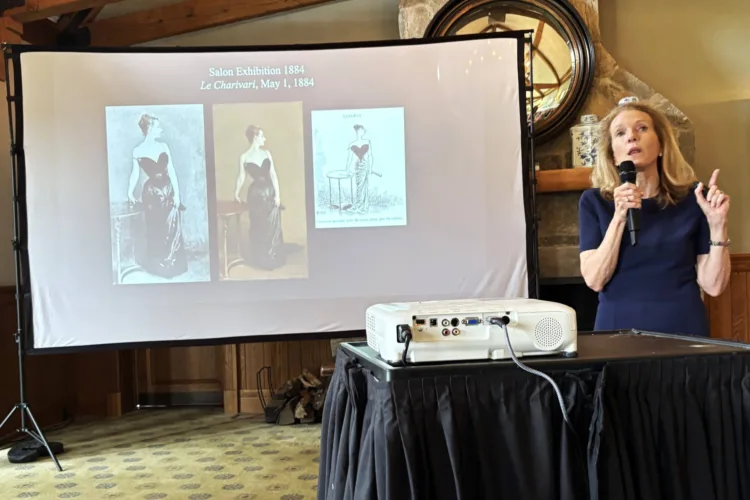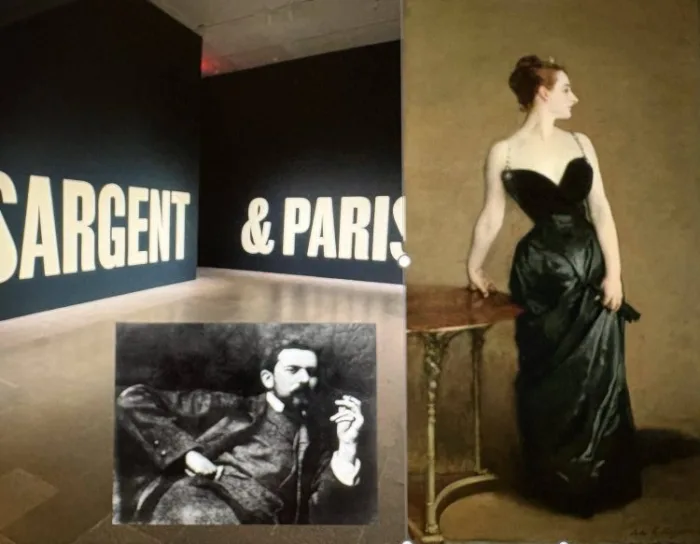On my watch: Page Knox Tells the Extraordinary Story of John Singer Sargent’s “Madame X”

By Anne W. Semmes
That infamous portrait of “Madame X” was the riveting subject at Wednesday week’s luncheon lecture of the Greenwich Branch of the English-Speaking Union at the Round Hill Club was so painted by John Singer Sargent. Capturing that moment in history in the 1880’s when Madame X was a scandalous success at the Paris Salon was Page Knox, a Greenwich treasure as lecturer. Page’s fascinating narrative flowed with verve and rich images. Her talk followed a recent closing of the Met’s exhibit of “Sargent and Paris” that featured its own “Madame X.”
So, Sargent is American, Page began, “His family goes back many generations to Boston in the 17th, 18th century” with his parents moved to Philadelphia. But with his father a doctor, their having lost their first child, they move to Florence in hopes of a better “medical system.” John, born in 1856 is followed by sister Emily, “a talented painter in her own right and still up at the Met is an exhibition devoted to Emily Sargent watercolors recently found by the family.” Count in the mother’s artistic interest. “She ensured that when her children, no matter where they were, they had a sketchbook in their hands, and they were always drawing.”
“So, Sargent basically spends his childhood coming of age in the Vatican, in the Uffizi, in all of these extraordinary collections,” Page told. At age 18 in 1874, Sargent’s family determines this “prolific” artist needs to go to Paris (en famille), with its “opportunities afforded to art students at the time.” He joins the studio of master painter Carolus-Duran.
“Sargent doesn’t want to be an impressionist…He wants to go the traditional route.” He wants to exhibit at the Paris Salon. “It was very hard to get into the Salon…about 1200 paintings selected from 7,000… So, you’ve got to recognize how you can make yourself stand out, but how you can conform to what the jury is looking for. And Sargent is the master of this…he recognized early on a color combination that was a winning combination for him…red, black and white. And you’re going to see this throughout Sargent’s work in this decade.”
At age 21 his portrait of Fanny Watts, a childhood friend, is accepted. “This was a very, very big deal for Sargent.” Sargent will take time off to travel, back to America. “The Sargents saw themselves as American, they were very proud of that…He wants to learn more about the New York art world and meet his family…Sargent is going to rely on his American friends.”
Sargent will travel extensively, but every year making an entry into the Salon “making a name for himself,” with portraits and winsome paintings of children. “He’s a draftsman, he knows how to make women look really good and he creates these kind of curved lines, and we’re going to see this again when he gets to his final triumph-disaster in 1884 with Madame X.”
By age 25 Sargent has “won as many medals as you can win,” and “at the Salon he becomes a member of the Academy… You don’t have to have a jury approve you, you can exhibit whatever you want – big opportunity.” His 1882 portrait of Dr. Pozzi in his red robe is a sensation. “Sargent has made so much success and starts kind of thinking about what am I going to do next? He starts wooing Madame X, but she’s not ready for him and he’s not ready for her.”
So, who is Madame [X] Pierre Gautreau? Her name, Virginie Amélie Avegno. “She is in fact American, from New Orleans,” Page told. “Her father was killed in the Battle of Shiloh…all the mother had at her disposal was her beautiful daughter.” They travel to Paris for her daughter “to meet a wealthy husband…She meets Monsieur Gautreau. He’s more than twice her age – she’s 18, he’s 38, happily married because now Madame can live in style…She goes to the opera not to see the show, but for people to see her, she has a very well publicized beauty routine, powders her chest with arsenic, which you don’t really want to do….She saw herself as the goddess Diana.”
“Sargent decides he needs to do something big for the 1884 Salon.” He sends a friend to her. She first refuses then when told 500,000 people will be attending, she agrees. Sargent peruses “what pose is going to work. “He turned her in profile. So, Leonardo said the eyes are the window to the soul, you get to know people by looking them in the eye. You don’t look her in the eyes; you don’t really know her.”
Regarding her dress – in those days women in portraits “have clothing right up to their chins.” But it was Madame who chose her dress, “So, she is very unusual. Most women were not this revealed. She poses for Sargent… So, if you do this for a long time, you’re going to get antsy, you’re going to get itchy. So, she’s doing this and that and the next thing you know down goes the strap…and Sargent says, look at that line of beauty. It’s even more accentuated with the curve of your body. Let’s keep it. And she says, ‘I won’t!”
That painting is hung in the Salon. “Everyone is talking about this picture and not in a good way, people think that Madame X is a harlot, she’s an American. All the insults…They thought that the strap was salacious, was absolutely outrageous.” And yet also on the walls were those nude women…What angered was, “Sargent was American…It’s time for them to go. So poor Virginie becomes the subject of all of these satirical prints. Her mother contacts Sargent, ‘Paint the strap back up! You are destroying my daughter. Her reputation has been ruined.’ And Sargent says, ‘I’m so sorry, but I can’t, it’s against the rules, it stays on the wall, six long weeks.’”
At end of the exhibit, there will be no purchase of Madame X. A story goes that Sargent, seeing the painting as “probably one of the better things” that he’s done decides to keep it in his apartment in Paris. But “the writing is on the wall; he needs to get out of town. No commissions, no one knocking at his doorstep. He’s scandal. So, he decides to leave, and he will take Madame X with him to London, and she will remain by his side in his studio for the rest of her life… And upon Virginie’s death, Sargent sells the picture to the Met [in 1916],” and Sargent will live until 1925. Thus, “this is the hundredth anniversary of his death.”
Sargent would paint “many things in addition to being a portrait painter. He will paint landscapes; he will engage in impressionism. He will paint the ceiling of the Boston Public Library. He goes to the front in WWI… but it is for his portraits that we remember him most.” He would paint “extraordinary portraits up until about 1900,” Page noted, “when he basically says, ‘I’ll paint your barn, I’ll paint your fence. Just not your portrait. I’m done.’” But it’s those portraits of the Paris years that Page sees as “so extraordinary, that keep people coming.”





